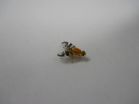INFORMATION:
Is fleet diversity key to sustainable fisheries?
In a new paper, Bren School postdoctoral researcher Matt Burgess suggests that it is
2014-10-31
(Press-News.org) Santa Barbara, Calif. — Concern about fisheries is widespread around the world. Over the past several decades, a robust discussion has taken place concerning how to manage fisheries better to benefit ecosystems and humans. Much of the discussion has focused on preserving biological diversity, a critical component of healthy ecosystems. One aspect that gets less attention is the role of fishing fleet diversity.
Fishing fleets can be diverse in many ways, including the gear they use, the fishing grounds they visit and when, and the species they target. A new study by a researcher at the Bren School of Environmental Science & Management at the University of California, Santa Barbara suggests that fleet diversity is important to fishery management success, and can even improve the sustainability of fisheries that aren't managed.
Titled "Consequences of fleet diversification in managed and unmanaged fisheries" and written by Sustainable Fisheries Group postdoctoral scholar Matt Burgess, the study was published today in the e-First section of the Canadian Journal of Fisheries and Aquatic Sciences.
Burgess used a mathematical model to show that fleet diversity helps managers by giving them more management options, which is especially important in fisheries that target multiple species. In such fisheries, it can be difficult to reduce overfishing of slow-growing species like marlin and rockfish without under-fishing faster-growing species like tunas and sole. Under-fishing negatively impacts the industry by leaving profits in the sea, while changing fishing gear to be more selective and, thus, leave more of the slow-growing species in the water, can be difficult and costly. But in a diverse fleet, rather than having to make gear more selective or sacrifice the catch of robust species, managers can balance catches across species by influencing how fishing effort is allocated among different fishing strategies. Being able to balance catches better across species allows diverse fishing fleets to increase overall catches and profits, while reducing overfishing at the same time.
"For managers, the challenge is helping a diverse fleet achieve this potential," says Burgess.
One management strategy that has shown promise recently is individual fishing quotas (IFQs). The IFQ approach allows managers to set catch limits for each species in a multispecies fishery and assign a share of the catch – a quota – to each fishing vessel at the start of the season. Vessel owners can then either catch their quota or sell parts of it to other fishermen. In theory, this system gives fishermen an incentive to balance their catches as efficiently as possible across species. IFQs have been adopted recently in trawl fisheries in British Columbia and the U.S. west coast. There is evidence in both cases that tradeoffs previously required to protect slow-growing species while profiting from fast-growing species have been lessened.
Burgess's theory also predicts that diversifying fleets could reduce overfishing of slow-growing species even without management, because competition within a diverse fleet should promote more balanced catches. If correct, that approach could offer hope for multinational fisheries on the high seas, which are notoriously difficult to manage.
"This might be what's going on in the high seas tuna fisheries of the western and central Pacific," Burgess suggests. In a previous study, he and colleagues at UCSB and the University of Minnesota found that the relative impacts of the western and central Pacific tuna fisheries on tuna and marlin species gradually became more balanced after deep-set longline and purse-seine fishing strategies were introduced in the 1970s. These fisheries had been previously dominated by shallow-set longline fishing, which is known for high by-catch rates.
ELSE PRESS RELEASES FROM THIS DATE:
Captive rhinos exposed to urban rumbles
2014-10-31
WASHINGTON, D.C., October 31, 2014 -- The soundtrack to a wild rhinoceros's life is wind passing through the savannah grass, birds chirping, and distant animals moving across the plains. But a rhinoceros in a zoo listens to children screaming, cars passing, and the persistent hum of urban life.
A group of researchers from Texas believes that this discrepancy in soundscape may be contributing to rhinos' difficulties thriving and reproducing in captivity. During the 168th Meeting of the Acoustical Society of America (ASA), which will be held October 27-31, 2014, at the ...
Insomnia increases risk of motor vehicle deaths, other fatal injuries
2014-10-31
DARIEN, IL – New research suggests that insomnia is a major contributor to deaths caused by motor vehicle crashes and other unintentional fatal injuries. The results underscore the importance of the "Sleep Well, Be Well" campaign of the National Healthy Sleep Awareness Project.
Results show that the risk of unintentional fatal injury increased in a dose-dependent manner with the number of insomnia symptoms present. People with all three symptoms of insomnia were 2.8 times more likely to die from a fatal injury than those with no insomnia symptoms, even after adjusting ...
Advance directives can benefit patients, families, and health care system
2014-10-31
Nearly one out of four older Americans say that either they or a family member have experienced excessive or unwanted medical treatment, according to the latest issue of The Gerontological Society of America's Public Policy & Aging Report (PP&AR), which goes on to show that Americans strongly support holding doctors accountable when they fail to honor patients' end-of-life health care wishes.
This PP&AR, titled "Advanced Illness Care: Issues and Options," features 12 articles that present new ways of understanding the complexity of securing appropriate advanced illness ...
A new generation of storage -- ring
2014-10-31
A bright synchrotron source that emits over a wide part of the electromagnetic spectrum from the infrared to hard X-rays is currently being built in Lund, Sweden. The MAX IV facility presents a range of technical challenges for the team putting together its component parts in a storage - ring synchrotron system that will have a circumference of just a few hundred metres. Nevertheless, if these various challenges can be addressed then an entirely new class of experiments that require source brightness and transverse coherence will be possible.
Pedro Tavares and colleagues ...
Viewing cancer on the move: New device yields close-up look at metastasis
2014-10-31
Johns Hopkins engineers have invented a lab device to give cancer researchers an unprecedented microscopic look at metastasis, the complex way that tumor cells spread through the body, causing more than 90 percent of cancer-related deaths. By shedding light on precisely how tumor cells travel, the device could uncover new ways to keep cancer in check.
The inventors, from the university's Whiting School of Engineering and its Institute for NanoBioTechnology (INBT), published details and images from their new system recently in the journal Cancer Research. Their article ...
Lack of oxygen delayed the rise of animals on Earth
2014-10-31
New Haven, Conn. – Geologists are letting the air out of a nagging mystery about the development of animal life on Earth.
Scientists have long speculated as to why animal species didn't flourish sooner, once sufficient oxygen covered the Earth's surface. Animals began to prosper at the end of the Proterozoic period, about 800 million years ago — but what about the billion-year stretch before that, when most researchers think there also was plenty of oxygen?
Well, it seems the air wasn't so great then, after all.
In a study published Oct. 30 in Science, ...
NASA sees remnants of Nilofar go to cyclone graveyard
2014-10-31
Wind shear has caused the demise of former Tropical Cyclone Nilofar in the northern Arabian Sea. NASA's Aqua satellite passed over Nilofar on Oct. 31 and captured an image that shows strong wind shear has pushed the bulk of clouds and showers away from Nilofar's center, basically sending the storm to its grave.
The Moderate Resolution Imaging Spectroradiometer aboard NASA's Aqua satellite captured an image of the remnants of Tropical Cyclone Nilofar on Oct. 31 at 08:45 UTC (4:45 a.m. EDT). The image showed that the former tropical cyclone's clouds and showers were pushed ...
Proton therapy shown to be less costly than some alternative radiotherapy techniques
2014-10-31
In terms of duration of treatment and cost, patients with early stage breast cancer may benefit from accelerated partial breast irradiation (APBI) with proton therapy versus whole breast irradiation (WBI), according to new research from The University of Texas MD Anderson Proton Therapy Center.
In a cost analysis study based on typical patient characteristics, researchers used Medicare reimbursement codes to analyze allowable charges for eight different types of partial and whole breast irradiation therapies and treatment schedules available to early stage breast cancer ...
Green spaces don't ensure biodiversity in urban areas
2014-10-31
Planting trees and creating green space in cities is good for attracting species, but it may not be enough to ensure biodiversity in built environments, a University of Iowa study has found.
The researchers surveyed two types of tree in an urban area in Iowa, and recorded the abundance of two insects that interact with them. They found that while there were plenty of the trees, black cherry and black walnut, they didn't find a corresponding abundance of the insects, in this case fruit flies that feed on the walnuts and black cherries and a type of wasp that feeds on the ...
Improved mouse model will accelerate research on potential Ebola vaccines, treatments
2014-10-31
In the war against Ebola one important hurdle has just been cleared – by a mouse.
Researchers at the University of North Carolina at Chapel Hill and colleagues have developed the first genetic strain of mice that can be infected with Ebola and display symptoms similar to those that humans experience. This work, published in the current issue of Science, will significantly improve basic research on Ebola treatments and vaccines, which are desperately needed to curb the worldwide public health and economic toll of the disease.
"You can't look for a cure for Ebola ...
LAST 30 PRESS RELEASES:
Norbert Holtkamp appointed director of Fermi National Accelerator Laboratory
New agentic AI platform accelerates advanced optics design
Biologists discover neurons use physical signals — not electricity — to stabilize communication
Researchers discover that a hormone can access the brain by hitchhiking
University of Oklahoma researcher awarded funding to pursue AI-powered material design
Exploring how the visual system recovers following injury
Support for parents with infants at pediatric check-ups leads to better reading and math skills in elementary school
Kids’ behavioral health is a growing share of family health costs
Day & night: Cancer disrupts the brain’s natural rhythm
COVID-19 vaccination significantly reduces risk to pregnant women and baby
The role of vaccination in maternal and perinatal outcomes associated with COVID-19 in pregnancy
Mayo Clinic smartwatch system helps parents shorten and defuse children's severe tantrums early
Behavioral health spending spikes to 40% of all children’s health expenditures, nearly doubling in a decade
Digital cognitive behavioral treatment for generalized anxiety disorder
Expenditures for pediatric behavioral health care over time and estimated family financial burden
Air conditioning in nursing homes and mortality during extreme heat
The Alps to lose a record number of glaciers in the next decade
What makes a good proton conductor?
New science reporting guide published for journalists in Bulgaria
New international study reveals major survival gaps among children with cancer
New science reporting guide published for journalists in Turkey
Scientists develop a smarter mRNA therapy that knows which cells to target
Neuroanatomy-informed brain–machine hybrid intelligence for robust acoustic target detection
Eight SwRI hydrogen projects funded by ENERGYWERX
The Lundquist Institute and its start-up company Vitalex Biosciences Announces Strategic Advancement of Second-Generation fungal Vaccine VXV-01 through Phase 1 Trials under $40 Million Competitive Con
Fine particles in pollution are associated with early signs of autoimmune disease
Review article | Towards a Global Ground-Based Earth Observatory (GGBEO): Leveraging existing systems and networks
Penn and UMich create world’s smallest programmable, autonomous robots
Cleveland researchers launch first major study to address ‘hidden performance killer’ in athletes
To connect across politics, try saying what you oppose
[Press-News.org] Is fleet diversity key to sustainable fisheries?In a new paper, Bren School postdoctoral researcher Matt Burgess suggests that it is






